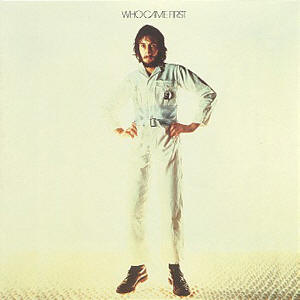
Pete Townshend As Depicted On The Cover Of His First Solo Record, "Who Came First" (1972)
Pete Townshend’s love for Indian Avatar Meher Baba produced the critically-acclaimed Tommy album in 1969, but there was more to it. As a “Baba Lover”, Townshend was involved with other devotees in the production and internal release of albums that included not only music but also poetry readings. Those were to fall into the hands of bootleggers and be repackaged before too long, and that was the reason Pete’s record company offered him the chance to assemble an official disc. That disc was to be named “Who Came First”, it was issued in 1972, and it was to be Pete’s first release outside of The Who.
As I explained in the general introduction to Pete’s music, “Who Came First” was not really a “solo” album as a literal host contributed to the record. Caleb Quaye, Ronnie Lane and Billy Nicholls lent their interpretative skills to three of the nine tracks that were featured on “Who Came First”, and the album also included a painting by Mike McInnerney (he who had illustrated “Tommy”). Lyrics were likewise composed by other Baba lovers, with both McInnerney’s wife and Maud Kelly having writing credits of their own.
Pete provided some Who demos, a few original numbers and an adaptation of Baba’s Universal Prayer (“Parvardigar”). He also tackled Jim Reeves’ “There’s An Heartache Following Me”, as it was one of Baba’s favorite Western songs. The other was “Begin The Beguine”, and Pete did also cover it on another of those tribute albums. It didn’t make it into “Who Came First”, though.
The Who demos included “Pure & Easy” and “Let’s See Action”. The inclusion of “Pure & Easy” was phenomenal if only because a Who version was not issued until the “Odds & Sods” album almost 5 years later. The song was the genesis of the whole “Lifehouse” project, and its omission on the “Who’s Next” disc has always been mourned. As Dave Marsh said, it wouldn’t have “saved” the album itself. Rather, it would have “perfected” it.
“Let’s See Action” was one of the “Lifehouse” leftovers that was released as a single, with the others being “Join Together” and “Relay”. Pete’s own demo doubles the running time, and it is one of these songs that were clearly meant to be sung by Roger. Who could sing a call to arms better than him, after all?
That is the main difference between the Who’s frontman and the band’s composer. As part of the general introduction I penned yesterday I made a point of Roger being a ballsier performer, while Pete takes a more delicate approach. You can understand it if you see it in these terms: Roger is the kind of guy who fights his way out of trouble. Pete is the fellow who talks his way out if it. Pete has a completely sly way of singing. His lyrics are witty, and so is the way he sings them. You can sample that marvelously on a song from his next record, the one he issued in 1977 with Ronnie Lane. The song is called “Misunderstood”, and it has a charm that ensnares just anybody.
That wit and that charm are also in evidence on the CD rerelease of “Who Came First”. Six songs have been added, and they are all tunes by Pete – his demo of “The Seeker” and five original compositions (two of which are instrumental cuts).
Such a wealth of bonus material definitely makes it resemble more of a Townshend solo album. And his witty delivery sparkles on “Sleeping Dog”, a song in which he gives unlimited faith a wry twist as he shows that even devotion has some physical limitations after all. Another of the new tracks is “Day Of Silence”, a very serene composition on the Avatar who led a life of silence in pursuit of the word of all words. It is the one composition of Pete’s that truly made me interested in Meher Baba. Although it didn’t make a believer out of me, I was spurred on to do some basic research.
(Continue to Part 2)

Pingback: Pete Townshend – General Introduction | MusicKO
Pingback: Who Came First (Pete Townshend) – Album Review (Part 2) | MusicKO
Pingback: Empty Glass (Pete Townshend) – Album Review | MusicKO
Pingback: Odds & Sods (The Who) – Album Review (Part 2) | MusicKO